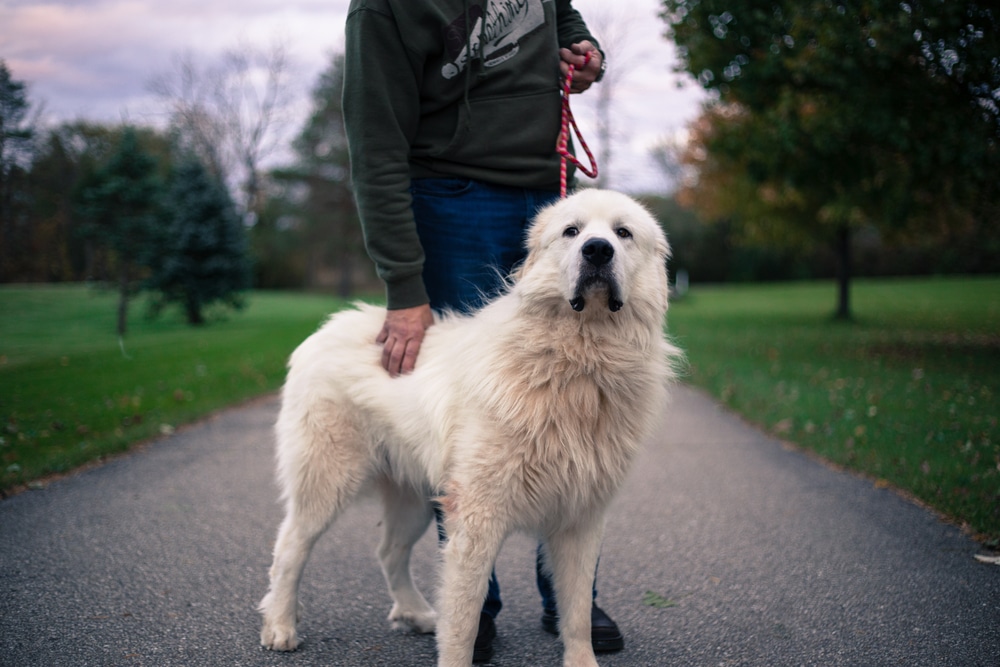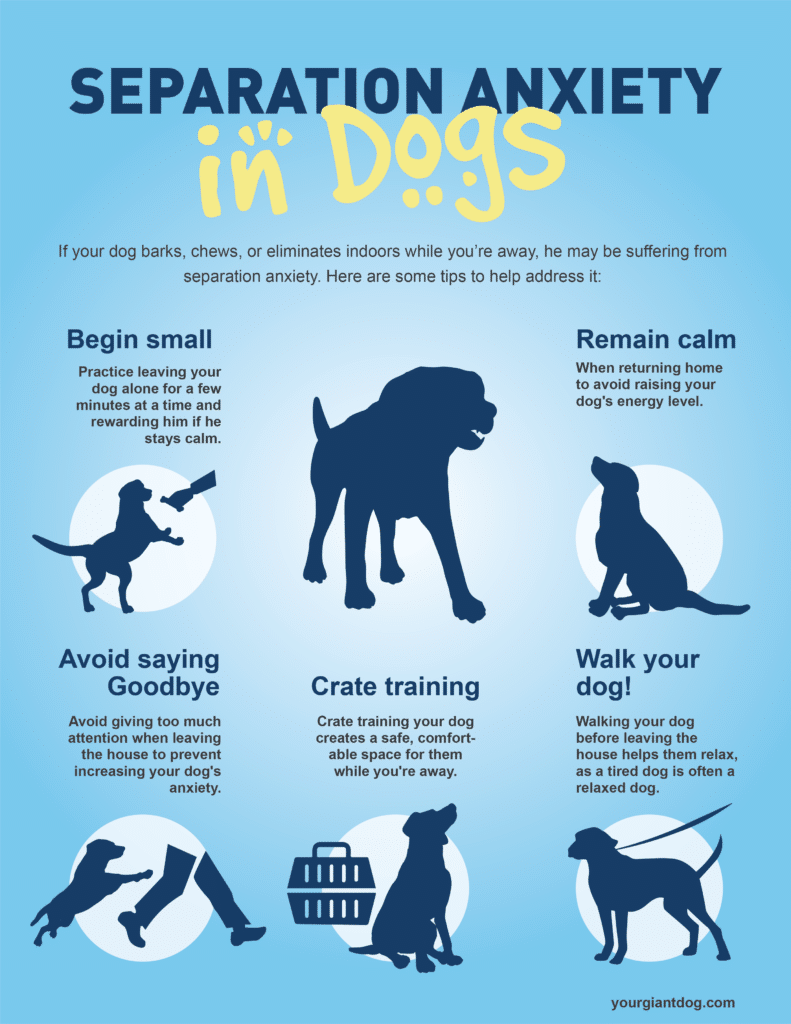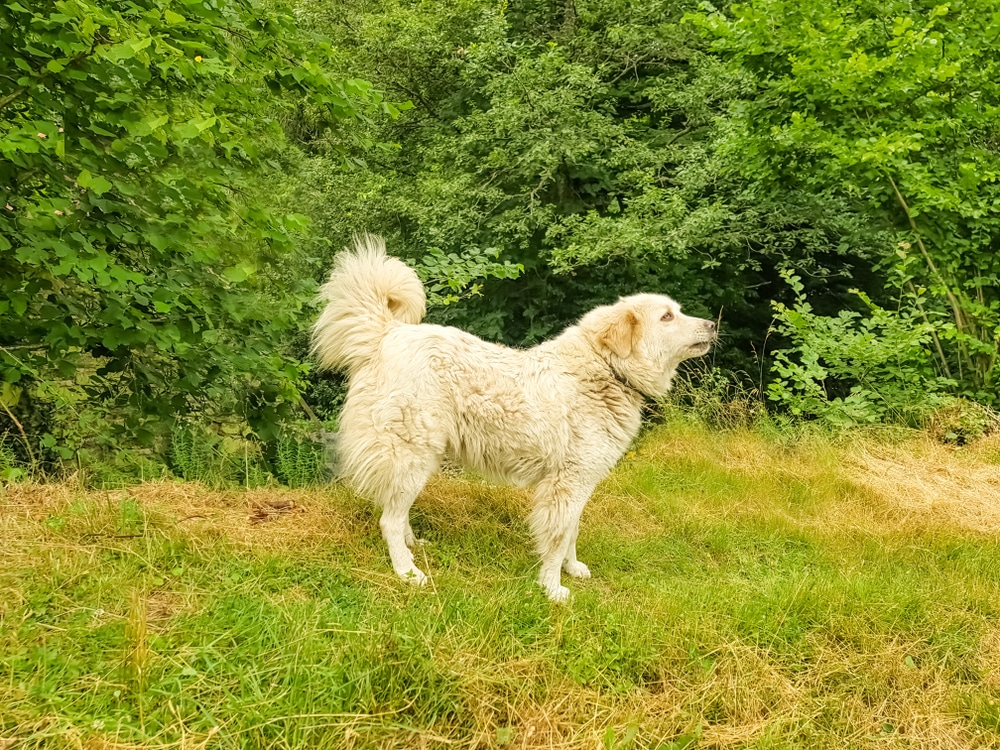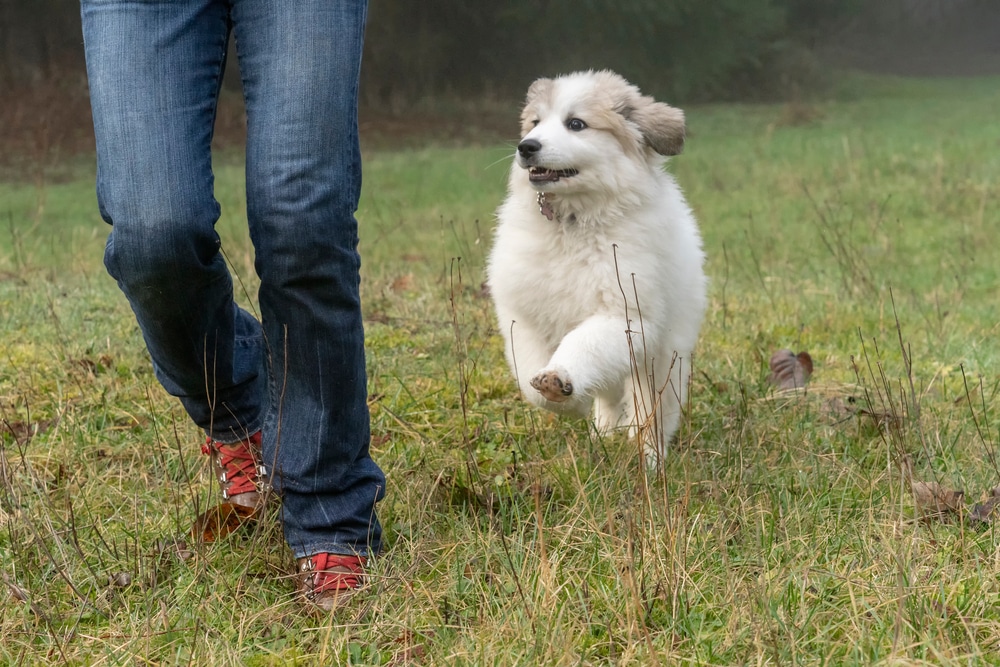Are you considering adding the Great Pyrenees to your beloved family? If so, you’ve come to the right place!
As a first-time owner of this majestic active breed, it’s important to understand what sets them apart from other species and how to care for them properly.
This article will provide insight into the basic needs of these beautiful animals and give guidance on how to help them adjust to their new home.
We include their training, exercise and grooming needs, behaviors to be aware of, and more. Let’s get started!
What First-Time Owners Need to Know about the Great Pyrenees
The Great Pyrenees are Stubborn
Great Pyrenees are known for being stubborn dogs. If you’re familiar with this breed, then you know that getting them to listen can be a challenge. So why are they so headstrong? It all comes down to the breed’s history and natural instincts.
This breed was bred to work independently without supervision and protect large flocks of sheep from predators. Both characteristics influence their personality today.
As such, these dogs tend to be more independent than other athletic breeds and often think for themselves instead of relying on their owners for instruction.
“This tenacious attitude is what makes them great guard dogs but also very stubborn when it comes to obedience training!”
They Need Regular Training
If you’re the proud first-time owner of a Great Pyrenees, one of your first questions might be: do they need regular training? The answer is yes!
Great Pyrenees are intelligent dogs, and just like any other pup, they need to learn how to interact with humans and their environment. Training a Great Pyrenees can be challenging, but it’s not impossible!
These dogs are independent thinkers and don’t respond well to harsh methods. Instead, use positive reinforcement when teaching them commands like ‘sit,’ ‘stay,’ or ‘come.’
Keep the sessions short and enjoyable, so they stay motivated throughout the process. Reward good behavior with treats or praise – both will go a long way in helping them learn new things.
Regular Grooming is Required
Caring for the Great Pyrenees requires more than just daily exercise, walks, and occasional baths. The majestic dog breed is known for its thick double coat that requires regular brushing and coat grooming to keep it looking its best.
Grooming their coat should be done at least once a week to ensure the fur remains healthy and free of debris and from matting or tangles. Regular brushing also helps spread natural oils throughout their hair, promoting healthy growth, and a nice sheen.
It’s also an excellent way to bond with your pet, so take advantage of this time together!
“If you don’t have the time (or patience) for all that weekly brushing, there are professional groomers who specialize in this breed and can help maintain their outer coat with regular trims or shaves.”
They Calm Down after 2 years.

The first two years of life are typically the most energetic for a Great Pyrenees pup. During this time, it’s important to set boundaries and start teaching them obedience and basic commands like sit or stay.
This will help lay the foundation for more advanced behaviors in the future. With consistency and positive reinforcement, your dog will learn quickly that good behavior gets rewarded! Once you’ve established a routine for your pup, they’ll begin to settle into adulthood.
They Suffer from Separation Anxiety
The majestic Great Pyrenees is often seen as a solid and independent breed. However, this doesn’t necessarily mean that they don’t suffer from separation anxiety.
While it isn’t common behavior for the Great Pyrenees to suffer from this condition, it can still happen in some cases. Separation anxiety occurs when a dog becomes overly attached to its owner, resulting in destructive behaviors such as excessive barking level, howling, and even chewing on furniture or items when left alone.
If The Great Pyrenees are exposed to too much change or disrupt their routine, they may develop separation anxiety.
Signs of distress can start appearing as soon as an owner leaves the home, so it’s important to be aware of any changes in behavior that could signal this issue.
Thankfully, treatments are available for those who believe their pup is struggling with separation anxiety.

They Bark a Lot
The Great Pyrenees is known for its loyalty and affectionate nature, not barking tendencies. Their bark is actually relatively quiet compared to another calm breed.
This majestic breed has more of a howl than a bark, which can be especially useful if your pup needs help finding its way back home! That being said, they will still alert you if someone approaches the house. If there are environmental changes, that might be concerning.
They won’t bark excessively, though – just enough to let you know something’s up.
Are Great Pyrenees Aggressive?

There are 5 key scenarios that may result in the Great Pyrenees showing signs of aggression. We explore these below:
Fear Aggression
Aggression is triggered by fear in dogs and is a severe behavioral issue that can cause dangerous situations if not addressed. This typically happens when dogs encounter new or unfamiliar stimuli that they perceive as a threat.
It often manifests as barking, growling, snapping, lunging, or biting – all signs that your pup feels uncomfortable and needs help calming down. In the case of the Great Pyrenees breed specifically, they may display this behavior due to their natural guarding instinct combined with their independent spirit.
If you notice your dog displaying any of these signs, it’s important to act quickly and effectively to help him resolve his fears.
“Identifying the cause of their fear should be the immediate focus. If you’re not able to alleviate their fear by addressing the triggers, then engaging a professional dog trainer or behaviorist may be required.”
Territorial Aggression
The Great Pyrenees can sometimes show hostility or aggression towards strangers if they feel threatened or scared. No matter how rare, this behavior should not be taken lightly!
If your pup starts exhibiting signs of aggression, such as growling or baring its teeth when someone unfamiliar enters your home, it’s important to take preventative measures to ensure things don’t get out of hand.
The key is to nip it in the bud by providing recall training and early socialization.
Predatory Aggression
Predatory aggression in dogs is different from other types of aggressive behavior. It involves hunting down prey and attacking them with full force.
While this may seem terrifying, predatory aggression doesn’t necessarily mean that your pup has become dangerous or unpredictable.
In fact, the Great Pyrenees have been known to exhibit this type of aggression towards small animals like cats and rodents. However, their owners rarely find themselves on the receiving end of it!
Proper training and socialization from an early age is the key to managing any canine aggression.
Intra-Household Aggression
Intra-household aggression is a type of behavior displayed by dogs living in multi-dog households. It occurs when a dog within the home begins to display aggressive behaviors, such as growling, biting and attacking other dogs in the home.
This can be very dangerous for both humans and animals alike, so it’s important to understand what causes this behavior.
When it comes to the Great Pyrenees, they are known for being gentle giants who usually get along well with other animals and people.
Despite their gentle nature, some exhibit intra-household aggression, especially if they feel threatened or challenged by other dogs within their environment.
The key is to provide them with a calm and loving atmosphere so they don’t need to resort to aggression.
Resource Guarding
Resource guarding is a behavior in which an animal guards or protects objects, food, and other resources from being taken away or disturbed by other animals. It’s not uncommon for many breeds of dogs to exhibit this type of aggression, including the Great Pyrenees.
But just how common is resource guarding in the Great Pyrenees? This breed has a strong instinct to protect its owners, possessions, and property from danger. But do they carry that instinct into protecting resources such as food and toys?
The answer is yes. While it’s not always aggressive behavior, the Great Pyrenees can become possessive over things they deem as theirs and may be prone to growling or snapping if someone tries to take it away.
Fortunately, these behaviors can usually be managed through proper training and socialization.
How Can First-Time Owners Prepare for a Great Pyrenees?
Prepare your Home

Owning the Great Pyrenees can be an incredibly rewarding experience. Whether you’re bringing home your first pup or adding to your existing flock, there are some things you should do to prepare for a successful transition.
Your home is the most important factor in getting ready for your pup. Ensure safety and security for the large, powerful Great Pyrenees.
Make sure that any fences around your property are tall enough so they can’t jump them and sturdy enough so they won’t break through.
Also, keep any hazardous items out of reach and confirm that any gates are securely shut at all times!
Ensure the proper Nutrition is provided to Great Pyrenees
Fortunately, providing your Great Pyrenees with the right nutrition is not too difficult. Start by looking at their age. Puppies will need more energy than adults to fuel their growing bodies.
They also require certain vitamins and minerals that adult dogs don’t need as much. A good quality puppy food should have all this covered – ensure it matches your pup’s age range and meets their dietary needs.
“Adult Great Pyrenees may do well on an all-natural diet consisting of high-quality proteins, grains, vegetables, and fruits with limited amounts of carbohydrates.”
Organize Potty Training
Here are some tips to help you organize a potty training routine for your Great Pyrenees. First, pick an area of the yard that will be exclusively used for potty breaks.
Once you’ve done this, remember to take your pup outside regularly at the same times each day.
Establishing this routine early on helps them learn when it is time to go outside and do their business.
It also reinforces positive behaviors by rewarding your pup with treats or verbal praise after each successful outdoors trip. Once inside again, watch for signs that your pet needs a break, such as sniffing around or pacing in circles.
When you see this, take them outside to finish their business. Great Pyrenees are generally very clean dogs and won’t go to the bathroom inside unless they’re sick or upset about something.
If your pup has an accident inside, it may have an underlying common health concerns condition that needs attention.
Arrange Obedience Training
One of the most important steps first-time owners of the Great Pyrenees should take when preparing for their new pet is to arrange obedience training.
Doing so will help to ensure that the transition from a puppy or rescue dog into an adult goes more smoothly.
During obedience training, your pup will learn basic commands such as sit and stay and socialization skills, which are essential in helping them adjust to their new home environment and family members.
Socialize your Dog
Socializing with other animals and people is a key factor in raising the Great Pyrenees.
This breed can often come off as intimidating due to its size. Therefore, it’s important to introduce your pup to others and take him slowly or her on short walks around your neighborhood. And for the local park so, they get used to strangers and other animals.
Find a Local Veterinarian
One of the most important things for first-time owners of the Great Pyrenees is to find a local veterinarian. Doing research ahead of time will help you select one that understands how to care for this large and powerful giant breed properly.
Finding a vet should be at the top of your list when preparing for your new pup, especially since regular checkups are essential to spot any potential health issues early on and get them treated as soon as possible.
Do some research online or ask around in the community; it may be helpful to look into vets with experience treating larger guardian dog breeds like the Great Pyrenees.
Understand Vaccination Requirements For Great Pyrenees
Before committing to owning a Great Pyrenees, be sure to research the necessary vaccinations for this breed. Like all dogs, they should receive the core vaccines such as rabies, distemper-parvovirus (DHP), canine hepatitis and bordetella (kennel cough).
“Additionally, they may also need special vaccines depending on their environment or lifestyle.”
For example, if your pup spends time around other mammals or in areas with ticks or mosquitos, lyme disease and leptospirosis are important ones to consider getting vaccinated against.
How Often Should a Great Pyrenees be Exercised?

The Great Pyrenees has medium-energy levels and needs moderate activity to stay healthy.
The best way to achieve this is to make sure they get regular exercise daily.
Depending on age, size, and individual energy level, most experts recommend this breed gets at least 60 minutes of physical activity each day.
This can include activities such as jogging or taking them for long walks in the park. Make sure you provide plenty of playtime too – fetching a ball or chasing after sticks are great ways to get them moving!
Does the Great Pyrenees need Mental Stimulation?
This breed is also quite intelligent—so providing them with mental stimulation is essential for their overall happiness and well-being.
Mental stimulation can come in many forms, from interactive toys to puzzles or even agility training. It’s important that your pup gets enough physical exercise each day — however, their brains also need to be stimulated!
“Mental stimulation keeps your pup engaged and helps prevent boredom or destructive behaviors like excessive barking or chewing on furniture.”
Can the Great Pyrenees be Left Alone?
This breed shouldn’t be left along for long periods of time, as they’re accustomed to being around other people or animals.
If left alone in a yard or house for extended periods, they will likely become very lonely, leading to depression and destructive behaviors.
For this reason, it’s important that owners give them plenty of attention as they are family pets and family companions while they are home. Taking the pooch on regular walks and trips outside keeps them mentally and physically stimulated. Plus, it’s good bonding time!
Read More
Are The Great Pyrenees Nocturnal? And What to Watch out for!


